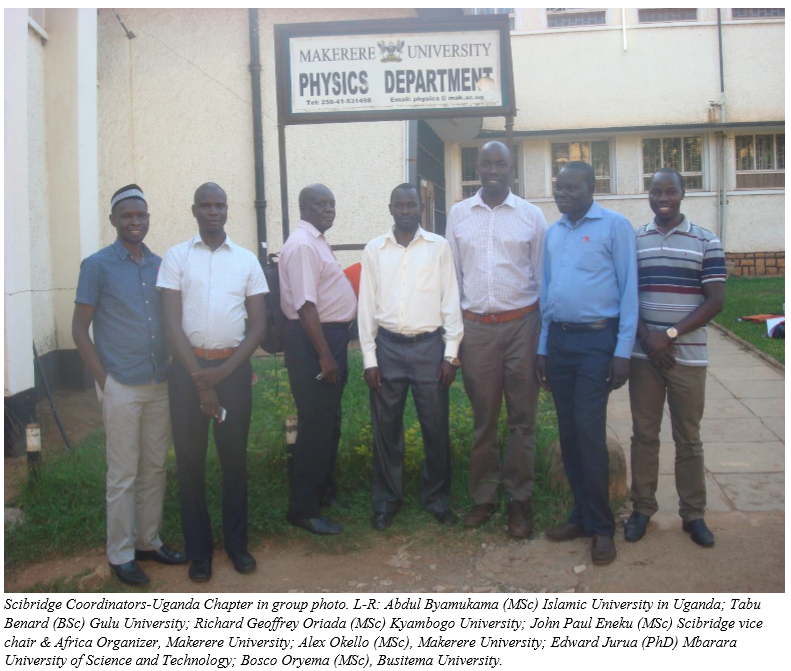|
Below is the report on our first African Coordinators Workshop which was held last summer. The report is compiled by John Paul Eneku, our primary SciBridge coordinator in Africa. Preamble Scibridge Project-Uganda Chapter has six member universities spread evenly across the country, Uganda. Two universities are located in the central region (Makerere University and Kyambogo University); another two lie in the eastern region (Islamic University in Uganda and Busitema University). While northern and western regions has each one university- Gulu University and Mbarara University of Science and Technology, respectively. They are all public or state owned universities. Makerere University is the overall coordination center and is managed by Mr. Eneku John Paul (MSc), Lecturer at the department of physics. The department of physics in each member university is the primary participating unit and undergraduate students of Bachelor of Science (Bsc) in physics plus their staff are involved in the collaboration and even graduate (MSc) students in some cases. The academic dialogue between Ugandan universities (students/staff) with their counterparts in the United States began in October 2014, with a novel science experiment kit (dye sensitized solar cell). In September 2014, a total of six experiment kits were sent to Uganda from University of Texas at Austin (one kit per university). The kits were mobilized and delivered under coordination of Dr. Veronica Augustyn (then a Postdoctoral Fellow) and a team of volunteer students of the same university. The benefiting universities supplement the kits with supplies that are readily available locally. These first kits had been assembled at The University of Texas at Austin but the experiment was originally developed at the California NanoSystems Institute at the University of California, Los Angeles. Thanks to the Materials Research Society Foundation Grassroots Grant which enabled the purchase of the kit supplies and shipping. The solar cell experiment allows Ugandan students to explore the relationship between materials, nanotechnology, energy and light. Once a class of students performed the experiments under the supervision of their lecturer, a web- seminar is arranged involving a U.S. researcher (live online), the students and their lecturer. Activity photos are taken and posted on the project websites: www.scibridge.org; www.facebook.com/scibridge; www.twitter.com/scibridge. On these websites, all participants (U.S. and African scientists) including the public follow collaboration events, receive latest news and easily network. Beyond the experiment exercise, students are inspired and motivated to do further investigations in the area of the experiment. Subsequently, in February 2015, again six additional kits were sent to Uganda (one per university) as additional supplies to support individual student projects on dye- sensitized solar cells. The scibridge project values the individual investigations as an important process of becoming a scientist. In all member universities quite a number of final year BSc physics students (undergraduates) routinely conduct individual investigation projects in dye sensitized solar cells. The research project is a requirement contained in their university curriculum. Students’ investigations explore the potential in natural dye extracts obtained from their rich-local environment as photosensitizers for dye sensitized solar cells. In one of the universities (Mbarara University of Science & Technology), even graduate MSc students completed researched topics in the area of dye sensitized solar cells. In April 2015, Ocean optics donated UV-VIS spectrometer to the scibridge project and later in the same month it was delivered to Uganda. The instrument supports students research related to dye- sensitized solar cells and in particular analyzing transmittance and absorbance of visible radiation by dye extracts (organic compounds) under investigation for use as photosensitizers in the solar cell. It’s a single instrument and so it is being shared among the six member universities. In May 2015, a second experiment developed by Texas Materials Institute, University of Texas was delivered to Uganda. In this experiment, students build an aluminum/air (Al/air) battery and then use this battery to light different color LED lights and power any other devices. Thanks to the Materials Research Society grant that funded the development of the kits and shipping. More experiments continue to be designed and assembled by the U.S based collaborators led by Scibridge group of North Carolina State University (U.S home of Scibridge). This activity is headed by Dr. Veronica Augustyn, Assistant Professor of the Department of Materials Science and Engineering in the same university. Generally, since the start of the scibridge project in October 2014, there has been a beehive of experiment and research activity at all member universities through the years 2014 and 2015. The records can be found on the project web-platforms. Due to inevitable challenges and interruptions the project activities slowed down in the year 2016. Whereas the project started way back in October 2014, no joint status review was conducted. The first project review for the Ugandan network was then held on July 1st, 2017 and participants were coordinators from all the six member universities. This workshop reviewed the project activities in the previous two years of its existence in Uganda. The activities included: to receive feedback on activities progress, experiences, challenges and make recommendations going forward. Work plans were drawn for the current and future activities. The workshop also provided an opportunity to receive a feedback report by Scibridge African organizer following a collaboration visit he completed to North Carolina State University (main Scibridge collaborator in the U.S.) between 17th-30th September 2016. Thanks to North Carolina State University for the East Africa Strategic Initiative grant that funded the collaboration visit of September 2016 and this workshop event. Further details of the aforementioned project activities are contained in the preceding pages of this report. Below is the full report as penned by John Paul Eneku available for download if you want to keep reading.
1 Comment
|
Archives
February 2023
|
||||||


 RSS Feed
RSS Feed
